
Wine Culture and Information since 2002 - Volume 22
 Wine Culture and Information since 2002 - Volume 22 |
|
Issue 127, March 2014 |
Contents |
|
|
The Wine I Like |
|
What is your favorite wine? What wine do you uncork when you do not have to do it because of your job and you like sharing it with friends? What is the best wine? This kind of questions are being frequently asked by the ones I know or the one I meet. I do not think the subject about my favorite wine is that interesting and, it can be, these are questions asked with a simple goal of starting a talk and to compare opinions. I admit it: to this kind of questions I always answer with a certain discomfort, not because I do not hare a favorite wine, indeed for the fact it is not just one. It is like cheating on all the other ones and favoring just one, while being aware of the fact also the favorite one is not my absolute favorite one. Sometimes these questions represent the attempt of getting a personal gratification in order to make sure about one's preferences and taste. It is also a way to start a discussion, while trying to understand my predilection or adversity towards a particular style, while defining a precise dichotomy between good and bad. This division, which certainly is completely subjective and personal, therefore debatable, also aims to the goal of judging one's intellectual and cultural position, by putting persons to one side or another. Moreover, in case I answer to these questions by simply saying I like good wines - an evidently trivial and however subjective concept - then the interlocutor reacts with a reassuring smile, imagining my concept of “good” certainly corresponds to his of her “good”. This answer, however, is certainly true for everyone of us, despite it is elusive and vague. After all, no one would answer to this kind of questions by saying his or her favorite wines are the “bad ones”. Good and bad are concepts to which everyone gives a personal meaning and value, most of the times defined in function of the intellectual and cultural contexts to which one feels to belong to. They are indisputable concepts in case they are considered as a personal expression only, of course respectable even though, most of the times, they are not truly agreeable. The annoying aspect, hypocrite and childish, it is when one believes his or her concept of good or bad must represent a “universal” and indisputable principle. Positions which are expressed, most of the times, with a disgusting arrogance, the typical behavior of the ones who cannot support and argue their position as well as not being aware of the fact there can also be other points of view. The sense of belonging to “something” - it is well known - is a cause of opposition among men as well as representing a reassuring social identity: history sadly repeating; we will never learn from the mistakes made by the ones who preceded us. For many - and this is something happening in other contexts as well - one's concept of good or bad wine also determines the classification of others in the “good” or “bad” side, experts or ignorants. Categories that, in any case and with no exception, are arbitrary and relative, therefore disputable in any form and principle. There has always been something in which wine has proved to be effective and successful, and this is sharing and sociality. Noble beverage having a high ritual meaning, wine has always been the perfect symbol of celebration and friendship. It can also be because of this reason I find it difficult to understand when wine it is used as a mean of division and speculation. I can understand, although with many exceptions, when this position is used by certain producers who, sometimes, believe this is the right way to promote their wines. Wine is also emotion and culture: not only the ones represented by its land and the men who made it, but also the emotion of the moment in which it is consumed. The context, company, the particular moment in which it is decided to uncork a bottle of wine and to share it, determine our positive feelings towards that wine. After all each one of us thinking about a wine remembers a particular moment - pleasing or unpleasing - and in which that wine has characterized that occasion. Memory certainly contributes to consider a wine good or bad in function of what has been associated to it and the moments in which the beverage of Bacchus was, for better or worse, part of the moment. Likewise, a wine meeting our ideal viticultural and wine making model - technical, cultural, intellectual or sentimental - is likely to be positively accepted. The sense of gratification and the confirmation to what we feel or think, it is undeniable, play an important role on how we consider a wine. What is, after all, the wine I like? I could answer, trivially, the wine I like is the one capable of contributing, in a particular moment, to make a certain occasion pleasing. In case I have to answer by excluding the sentimental involvement of the moment, the answer could be, maybe, more exhaustive and direct. I do appreciate, with no doubt at all, wines having no faults related to any nature or cause, capable of expressing elegance, balance and cleanness. I understand this is an answer which can be considered quite technical, but it is also true I do not like the arrogance of who, by justifying evidents faults, tries to support them as a good quality. Finally, I like the wine for what it is, expression of the ones who make it and with no pretension of using it in order to affirm something having nothing in common with wine while frequently having the sense of a silly arrogance. To me, this is a fault, too. Not of wine's - which has no fault in this - but of the silliness of the ones who believe it. Antonello Biancalana
|
||||
Man, Wine and TastingMan plays a fundamental role in the production and tasting of wine, not just an interpreter of vineyard but also of glass |
|
Wine is the product of a complex interaction occurring between Nature and man, result of many factors expressed in many forms and distinct ways, all being in function of the wine to be produced. Every factor, every single element concurring to the production of wine plays a role on the determination of its personality, in function of the way and form of their usage. Of these factors, man represents a determinant element in the production of wine, as he let and favor the interaction among the many elements and their expression. Interpreter more or less honest and sincere of a complex system, man gives wine his own character and his viticultural and wine making vision, frequently shaping wine according to his own interpretation. The role of man is not limited to production only. Wine is a product destined to the pleasure of men, representing, for certain aspects and, in particular, in past times, an essential element of subsistence. As such, it is subject to many interpretations, in a complex system involving all the senses of man, his emotionality, personality and culture. Hard to tell, according to this consideration, what is the best or worst wine, as this is intimately associated to what it represents to the one who is tasting it and to his or her personal gratification. On this regard, it seems appropriate to mention the words of the great French wine maker ╔mile Peynaud, one of the fundamental fathers of modern enology. «It is you (consumers) that in a certain way make quality. If there are bad wines it is because there are bad consumers. Taste follows the roughness of intellect: everyone drinks the wine he or she deserves». This can be seen as an extreme position and not agreed by many, however this is also true for good wines, as well as focusing, for better or worse, on the indisputable subjectivity in the determination of wine quality. This is a principle valid both for consumers and producers: there are bad wines because there are bad producers and bad consumers who buy them. It does not represent, of course, an absolute position. It is something arbitrary and relative, as everyone - either producer or consumer - has his or her own and intimate opinion about what a good or bad wine is. Moreover, everyone has his or her own opinion about what a wine should be in function of ethical, personal, organoleptic and cultural aspects, all of them being both respectable and objectionable by everyone.
The determination of wine quality, either objective or subjective, is expressed by a complex process beginning from vineyard and ending with the senses of the one who drinks it. Every element or factor involved in this process is fundamental to the definition of wine quality and of its interpretation. Every model of quality obeys to reference criteria in function of culture and definition of wine according to specific categories of producers and consumers. Some of them are more successful than other because of the better consensus they get in satisfying quality criteria accepted by the majority of producers and consumers, representing - as matter of fact - a reference model. Others, equally respectable and qualitatively expressive, get a progressively lesser appreciation in smaller categories of producers and consumers. The character and personality of wine take their origin from vineyard and from the territory in which it is cultivated. These two factors represent - as a matter of fact - a theoretical quality element, as the original potential quality can be altered and changed in function of the wine making vision of the producer. The goal is, in any case, making a wine by adopting viticultural and wine making techniques according to what a producer believes to be both ethical and commercially profitable for market and consumers. These two visions will determine, in a good extent, the fate of grapes and their subsequent transformation into wine. During the whole process of production - from vineyard to bottle - every choice, every operation done by man will significantly determine the quality of wine. On this regard it should be considered that without the indispensable intervention of man - as such - wine could not exist. Let's begin this journey from vineyard, by considering the most significant element determining the path to the glass. The choice of the variety to be planted in a vineyard represents the first and determinant factor for the character of wine. The many types of soil give specific agronomic characteristics and influence the life of vine and of its grape. Moreover, the rootstock - fundamental element useful for contrasting the devastating effects of phylloxera - greatly influence vine's life. Each rootstock in fact has specific characteristics capable of ensuring the supplying of nutrients and water to the vine in function of the soil in which it is planted. These three elements - soil, vine and rootstock - greatly determine the quality of grapes and the agronomic success of the vine in a territory. Territory, there is no doubt about this, plays a fundamental role on the expression of its grapes and its wines. The way with which man interacts with the relation “vine-territory” undeniably changes the result which can be obtained, frequently in function of his wine making vision and the respect of this system. Likewise, also the choice of phytosanitary treatments, indispensable measures for the control of vine diseases, affects the result and the expression of wines which can be obtained from a vineyard. Not less important, the pruning technique used for the vine and the type of training, influence the productive potential and the quality of grapes. The same consideration is true for all the agronomic practices done in vineyard, such as summer pruning, defoliation and bunch removal. Interventions man does on vine in order to improve the precious fruit which will become wine. The agronomic conduction of vineyard, an aspect totally depending on the intervention of man, represents a determinant factor influencing both quality and the organoleptic expression of wine. A factor determining, in a good extent, the diversity - sometimes remarkable - between two wines produced in the same territory and from bordering vineyards, however cultivated with different agronomic principles. Talking about vineyard, also the period of harvesting affects the character of a wine. It is sometimes a difficult choice to make, both because of the meteorological conditions of the year and for the compromise between physiologic and technological ripeness of grapes, in any case, it is a factor influencing the character of wine. Harvesting, in particular the moment of the day and the time passing from picking to crushing of grapes, can affect wine quality. Grapes then arrive to the winery and, also in this place, the intervention of man substantially affects the final product. It should be said it is in this place man can do most of his “magic” capable of drastically changing the character and a fate of a wine, for the better or worse. By using proper wine making techniques it is in fact possible to correct and change a wine in any aspect. These operations do not always bring to the improvement of wine: sometimes it can also happen the very opposite. High quality grapes can in fact be inappropriately processed and in a way which will make them lose their quality, with the result of obtaining a mediocre wine. Likewise, from grapes of mediocre quality we can get a wine, not of excellent quality, of course, however better than what the potential of grapes can offer. Sometimes, in the winery, can be made some good miracles as well as making unfortunate catastrophes. Wine making techniques give wine a specific personality and substantially determine its organoleptic character. Every added substance, every practice done on grape juice and wine - no matter how legitimate and acceptable they are - widely define its character. Quantity of sulfur dioxide - indispensable for many, deleterious for others - volume and type of containers used for the fermentation and aging of wine, use of selected or indigenous yeast: they are just simple examples which can determine technical and organoleptic development of wine. Choices undoubtedly representing the personal ethic values of the producer according to his or her wine vision and the relationship with the territory, grapes and winery, but they substantially affect the final result and what will be perceived from a glass. The role of man in the definition of the character and personality of a wine does not end in the winery. At the end of production, when the wine is finally released and commercialized, therefore purchased, for the bottle and its content begin a new life. A fate determined by many factors, by the way wine is being kept and sold, as well as how it is being consumed. Wine, it is commonly known, is a product in continuous evolution, ideally following its life cycle, made of youth and maturity, therefore an unavoidable decay. The moment in which a bottle of wine is finally uncorked represents a specific and unrepeatable condition of the wine determining its appreciation. In particular, the conditions of tasting, also by considering technical factors - temperature and glass in particular - will influence the organoleptic quality of wine and its perception. Finally, man determines the potential qualitative value of a wine also through other factors. Emotional state, context of consumption, personal culture and expectations towards a wine, will all be fundamental for the appreciation and the final evaluation of the beverage of Bacchus. A technically impeccable wine can also be considered insignificant when it does not meet the expectations and the wine making model of the one who drinks it. It is, last but not the least, a matter of prejudices towards specific wines and specific viticultural and wine making techniques, all influencing sensorial and emotional perception of a wine. Man, who is the interpreter of wine in every moment of its evolution, by taking advantage of the fundamental and essential contribution of Mother Nature, largely determines the character of wine. The goal is always the same: to make a wine capable of giving sensorial, ethical, intellectual, cultural, ritual and social gratification to the ones who make it and the ones who drink it.
|
||||||||||||
Wines of the Month |
|
|
|
Score legend Prices are to be considered as indicative. Prices may vary according to the country or the shop where wines are bought |
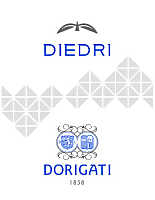
|
|
Teroldego Rotaliano Superiore Riserva Diedri 2010 |
|
| Dorigati (Trentino, Italy) | |
| Grapes: Teroldego | |
| Price: € 20.00 | Score: |
| Teroldego Rotaliano Superiore Riserva Diedri shows a deep ruby red color and nuances of ruby red, little transparency. The nose denotes intense, clean, pleasing, refined and elegant aromas which start with hints of black cherry, plum and pomegranate followed by aromas of violet, blackberry, blueberry, flint, vanilla, chocolate, tobacco and menthol. The mouth has good correspondence to the nose, a tannic attack and however balanced by alcohol, good body, intense flavors, agreeable. The finish is persistent with flavors of black cherry, plum and pomegranate. Teroldego Rotaliano Superiore Riserva Diedri ages for 12 months in barrique followed by 6 months of aging in bottle. | |
| Food Match: Roasted meat, Stewed and braised meat with mushrooms, Hard cheese | |
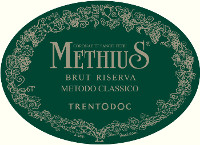
|
|
Trento Brut Riserva Methius 2007 |
|
| Dorigati (Trentino, Italy) | |
| Grapes: Chardonnay (60%), Pinot Noir (40%) | |
| Price: € 33.00 | Score: |
| Trento Brut Riserva Methius shows a pale straw yellow color and nuances of greenish yellow, very transparent, fine and persistent perlage. The nose reveals intense, clean, pleasing, refined and elegant aromas which start with hints of banana, apple and bread crust followed by aromas of kiwi, acacia, yeast, pear, plum, grapefruit, hazelnut, hawthorn and hints of vanilla. The mouth has excellent correspondence to the nose, an effervescent and crisp attack, however balanced by alcohol, good body, intense flavors, agreeable. The finish is very persistent with long flavors of banana, apple and kiwi. Part of the Chardonnay used for the base wine ferments in barrique. Trento Brut Riserva Methius referments in bottle on its lees for 5 years. | |
| Food Match: Roasted fish, Broiled crustaceans, Pasta and risotto with fish, Roasted white meat | |
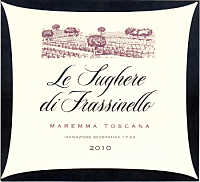
|
|
Le Sughere di Frassinello 2010 |
|
| Rocca di Frassinello (Tuscany, Italy) | |
| Grapes: Sangiovese (50%), Merlot (25%), Cabernet Sauvignon (25%) | |
| Price: € 18.00 | Score: |
| Le Sughere di Frassinello shows an intense ruby red color and nuances of ruby red, little transparency. The nose denotes intense, clean, pleasing and refined aromas which start with hints of black cherry, black currant and plum followed by aromas of violet, blueberry, chocolate, vanilla, tobacco, mace and eucalyptus. The mouth has good correspondence to the nose, a tannic attack and however balanced by alcohol, good body, intense flavors, agreeable. The finish is persistent with flavors of black cherry, black currant and plum. Le Sughere di Frassinello ages in barrique for 12 months followed by 9 months of aging in bottle. | |
| Food Match: Roasted meat, Stewed and braised meat, Hard cheese | |
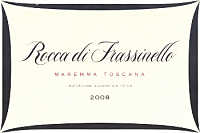
|
|
Rocca di Frassinello 2008 |
|
| Rocca di Frassinello (Tuscany, Italy) | |
| Grapes: Sangiovese (60%), Merlot (20%), Cabernet Sauvignon (20%) | |
| Price: € 38.00 | Score: |
| Rocca di Frassinello shows an intense ruby red color and nuances of garnet red, little transparency. The nose denotes intense, clean, pleasing, refined and elegant aromas which start with hints of plum, black cherry and black currant followed by aromas of dried violet, blueberry, blackberry, vanilla, tobacco, cocoa, mace, leather and menthol. The mouth has good correspondence to the nose, a tannic attack and however balanced by alcohol, full body, intense flavors, pleasing roundness. The finish is persistent with flavors of plum, black cherry and black currant. Rocca di Frassinello ages for 14 months in barrique followed by 11 months of aging in bottle. | |
| Food Match: Game, Roasted meat, Stewed and braised meat, Hard cheese | |
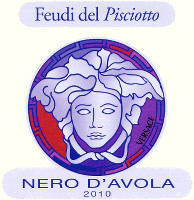
|
|
Nero d'Avola 2010 |
|
| Feudi del Pisciotto (Sicily, Italy) | |
| Grapes: Nero d'Avola | |
| Price: € 16.50 | Score: |
| This Nero d'Avola shows a brilliant ruby red color and nuances of garnet red, little transparency. The nose denotes intense, clean, pleasing and refined aromas that start with hints of plum, blackberry and dried violet followed by aromas of black cherry, blueberry, vanilla, carob, tobacco and cocoa. The mouth has good correspondence to the nose, a properly tannic attack and however balanced by alcohol, good body, intense flavors, agreeable. The finish is persistent with flavors of plum, blackberry and black cherry. This Nero d'Avola ages in barrique. | |
| Food Match: Broiled meat and barbecue, Roasted meat, Stewed meat, Hard cheese | |
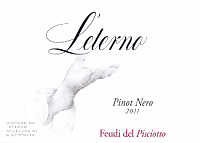
|
|
L'Eterno 2011 |
|
| Feudi del Pisciotto (Sicily, Italy) | |
| Grapes: Pinot Noir | |
| Price: € 48.00 | Score: |
| L'Eterno shows a brilliant ruby red color and nuances of garnet red, moderate transparency. The nose reveals intense, clean, pleasing, refined and elegant aromas which start with hints of cherry, plum and raspberry followed by aromas of cyclamen, violet, blueberry, vanilla, pink pepper, cocoa, tobacco and eucalyptus. The mouth has good correspondence to the nose, a properly tannic attack and however balanced by alcohol, good body, intense flavors, pleasing crispness. The finish is persistent with flavors of cherry, raspberry and plum. L'Eterno ages in barrique. | |
| Food Match: Roasted meat, Stewed meat with mushrooms, Hard cheese | |
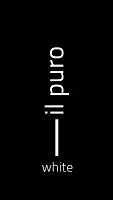
|
|
Il Puro Bianco 2011 |
|
| Villa Lupara (Campania, Italy) | |
| Grapes: Falanghina | |
| Price: € 3.90 - 500ml | Score: |
| Il Puro Bianco shows an intense straw yellow color and nuances of straw yellow, very transparent. The nose denotes intense, clean and pleasing aromas which start with hints of plum, quince and hawthorn followed by aromas of hazelnut, honey and pear. The mouth has good correspondence to the nose, a crisp attack and however balanced by alcohol, good body, intense flavors. The finish is persistent with flavors of quince, plum and pear. Il Puro Bianco ages for 6 months in steel tanks and it is made from late harvested grapes. | |
| Food Match: Pasta with fish, Broiled fish, Roasted white meat | |

|
|
Il Puro Nero 2009 |
|
| Villa Lupara (Campania, Italy) | |
| Grapes: Merlot (70%), Aglianico (30%) | |
| Price: € 3.90 - 500ml | Score: |
| Il Puro Nero shows an intense ruby red color and nuances of ruby red, little transparency. The nose denotes intense, clean, pleasing and refined aromas that start with hints of plum, black cherry and black currant followed by aromas of violet, blueberry, blackberry, tobacco, vanilla, chocolate and menthol. The mouth has good correspondence to the nose, a tannic attack and however balanced by alcohol, good body, intense flavors, pleasing roundness. The finish is persistent with flavors of black cherry, plum and black currant. Il Puro Nero ages in barrique for 12 months followed by 3 months of aging in bottle. | |
| Food Match: Broiled meat and barbecue, Roasted meat, Stewed meat, Hard cheese | |
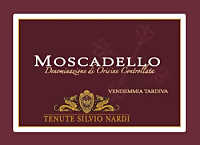
|
|
Moscadello di Montalcino 2010 |
|
| Tenute Silvio Nardi (Tuscany, Italy) | |
| Grapes: Muscat Blanc | |
| Price: € 20.00 - 500ml | Score: |
| This Moscadello di Montalcino shows a pale golden yellow color and nuances of golden yellow, transparent. The nose denotes intense, clean, pleasing and refined aromas which start with hints of raisin, dried apricot and lychee followed by aromas of candied fruits, almond, honey, citrus fruit peel, sage, lavender and nail polish. The mouth has good correspondence to the nose, a sweet and round attack, however balanced by alcohol, good body, intense flavors, pleasing crispness. The finish is persistent with flavors of raisin, dried apricot and honey. Thish Moscadello di Montalcino ages for 6 months in barrique. | |
| Food Match: Fruit tarts, Confectionery | |
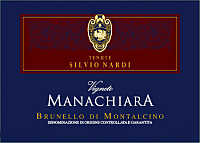
|
|
Brunello di Montalcino Vigneto Manachiara 2007 |
|
| Tenute Silvio Nardi (Tuscany, Italy) | |
| Grapes: Sangiovese | |
| Price: € 50.00 | Score: |
| Brunello di Montalcino Vigneto Manachiara shows a brilliant ruby red color and nuances of garnet red, moderate transparency. The nose denotes intense, clean, pleasing, refined and elegant aromas which start with hints of black cherry, plum and dried violet followed by aromas of blueberry, raspberry, cocoa, vanilla, leather, licorice, rose, mace, tobacco and menthol. The mouth has excellent correspondence to the nose, a tannic attack and however balanced by alcohol, full body, intense flavors, agreeable. The finish is very persistent with long flavors of plum, black cherry and raspberry. Brunello di Montalcino Vigneto Manachiara ages for 12 months in barrique, 12 months in cask and for more than one year in bottle. | |
| Food Match: Game, Stewed and braised meat, Roasted meat, Hard cheese | |
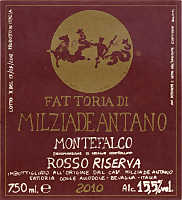
|
|
Montefalco Rosso Riserva 2010 |
|
| Fattoria Colleallodole - Milziade Antano (Umbria, Italy) | |
| Grapes: Sangiovese (65%), Sagrantino (15%), Merlot (15%), Cabernet Sauvignon (5%) | |
| Price: € 28.00 | Score: |
| Montefalco Rosso Riserva shows a brilliant ruby red color and nuances of ruby red, moderate transparency. The nose denotes intense, clean, pleasing and refined aromas which start with hints of plum, black cherry and blackberry followed by aromas of violet, raspberry, black currant, vanilla, tobacco, chocolate and menthol. The mouth has good correspondence to the nose, a properly tannic attack and however balanced by alcohol, good body, intense flavors, agreeable. The finish is persistent with flavors of plum, black cherry and blackberry. Montefalco Rosso Riserva ages for 36 months in cask followed by 6 months of aging in bottle. | |
| Food Match: Broiled meat and barbecue, Roasted meat, Stewed meat with mushrooms, Hard cheese | |
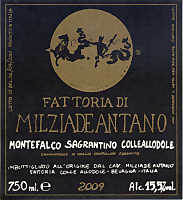
|
|
Montefalco Sagrantino Colleallodole 2009 |
|
| Fattoria Colleallodole - Milziade Antano (Umbria, Italy) | |
| Grapes: Sagrantino | |
| Price: € 60.00 | Score: |
| Montefalco Sagrantino Colleallodole shows a deep ruby red color and nuances of garnet red, little transparency. The nose reveals intense, clean, pleasing, refined and elegant aromas which start with hints of blackberry, black cherry and violet followed by aromas of plum, blueberry, cocoa, vanilla, tobacco, leather, mace, pink pepper, cinnamon and menthol. The mouth has good correspondence to the nose, a tannic attack and however balanced by alcohol, full body, intense flavors, pleasing roundness. The finish is very persistent with long flavors of blackberry, black cherry and plum. Montefalco Sagrantino Colleallodole ages for 18 months in cask followed by 6 months of aging in bottle. | |
| Food Match: Game, Stewed and braised meat, Hard cheese, Hard cheese | |
News |
|
In this section are published news and information about events concerning the world of wine and food. Whoever is interested in publishing this kind of information can send us a mail to our address.
|
Wine Parade |
|
|
| The best 15 wines according to DiWineTaste's readers. To express your best three wines send us an E-mail or fill in the form available at our WEB site. |
| Rank | Wine, Producer | |
|---|---|---|
| 1 |
| Brunello di Montalcino 2007, Donatella Cinelli Colombini |
| 2 |
| Verdicchio dei Castelli di Jesi Classico Superiore Podium 2010, Garofoli |
| 3 |
| Amarone della Valpolicella Classico Capitel Monte Olmi 2007, Tedeschi |
| 4 |
| Camartina 2008, Querciabella |
| 5 |
| Villa Gresti 2006, Tenuta San Leonardo |
| 6 |
| San Leonardo 2006, Tenuta San Leonardo |
| 7 |
| Trento Brut Riserva Methius 2006, Dorigati |
| 8 |
| Langhe Riesling Herzu 2011, Ettore Germano |
| 9 |
| Avvoltore 2009, Moris Farms |
| 10 |
| Brunello di Montalcino Vigna Loreto 2007, Mastrojanni |
| 11 |
| Sagrantino di Montefalco Collepiano 2007, Arnaldo Caprai |
| 12 |
| Pelago 2009, Umani Ronchi |
| 13 |
| Maximo 2010, Umani Ronchi |
| 14 |
| Trento Talento Brut Riserva 2007, Letrari |
| 15 |
| Confini 2007, Lis Neris |
| |||||||
Privacy Policy | |||||||


| Copyright © 2002-2024 Antonello Biancalana, DiWineTaste - All rights reserved |
| All rights reserved under international copyright conventions. No part of this publication and of this WEB site may be
reproduced or utilized in any form or by any means, electronic or mechanical, without permission in writing from DiWineTaste. |